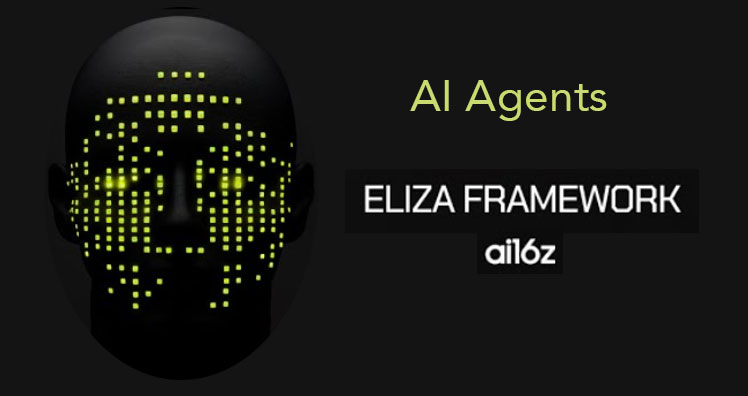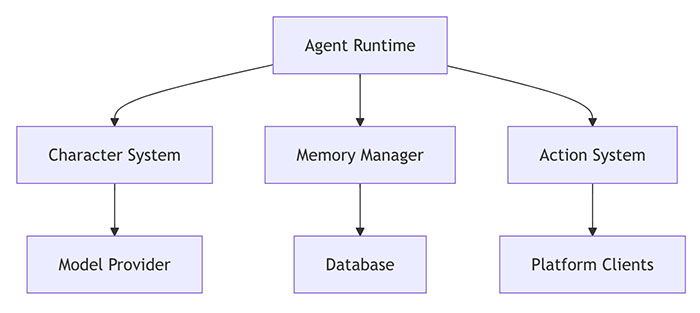
Exploring the Eliza Framework and ai16z
February 10, 2025


Eliza is an open-source, multi-agent simulation framework led by the developers of ai16z, an AI-driven DAO—not to be confused with Marc Andreessen's A16z. Shaw Walters, founder of Eliza Labs and ai16z DAO, and his team built the Eliza framework with TypeScript.
The goal is to provide a flexible platform for developers to build and deploy intelligent agents that can interact across multiple platforms like X, Discord, and Telegram. Eliza seeks to empower users and developers alike to create unique AI personalities.
Eliza can be used to create social media personas, AI assistants, automated content creators, personal assistants, community moderators, customer support agents, content analysts, research assistants, entertainment bots, educational tutors, engagement bots, brand representatives, knowledge workers, document processors, interactive and role-playing characters.
This article will explore the rise of AI agents and infrastructure in Web3, the Eliza project’s core capabilities and components, and how the framework is related to AI16z.
Rise of AI Infra
The crypto space was wide open when the agent meta kicked off last fall. Only a handful of agents existed, and almost no launchpads were tailored for agents. Nearly every agent token was worth trading back then because it would inevitably run.
But the crypto market doesn’t trade easily for long. The ecosystem is now flooded with agents, and finding winners requires diligence and luck. This saturation led to a shift. As picking agents became more difficult, the market moved to the next logical play: infrastructure. Providing infrastructure has always been a good business, which is what the Eliza framework offers.
Core Capabilities
Some of Eliza’s core capabilities are:
1. Multi-Agent Architecture
Developers can simultaneously deploy and manage multiple unique AI personalities.
2. Character System
The system allows users to create diverse agents within the framework.
3. Memory Management
Eliza uses an advanced Retrieval Augmented Generation (RAG) system for long-term memory and context awareness.
4. Platform Integration Communication and Media
Agents can seamlessly connect with Discord, X, and other platforms. Full-featured Discord integration with voice channel support is available, while bot capabilities exist with X.
5. Media Processing
Developers can implement audio transcription, video content processing, PDF reading, link content extraction, image analysis, and more.
Shaw designed Eliza to be accessible while maintaining powerful customization, scaling, and integration capabilities. It has an active community of developers and users contributing to this open-source project on GitHub. The community also provides comprehensive guides, examples, and support for troubleshooting issues.
Eliza's flexible configuration system supports multiple AI models, including Anthropic, Claude, Google, Grok, Heurist, Livepeer, Llama, OpenAI, and RedPill.

Eliza’s Core Components
The core components of ElizaOS are Agents, Clients, Providers, Actions, and Evaluators.
1. Agents
Eliza’s Agents handle autonomous interactions. These agents work in a runtime environment and can interact through clients like Telegram and Discord while maintaining consistent behavior and memory. Each agent runtime consists of vital components (Providers and Clients) that enable flexible functionality.
Providers inject real-time information with dynamic context into agent interactions. They bridge the agent and external systems to access market data, sentiment analysis, wallet information, and time-related context.
A Provider's job is to provide dynamic contextual information while integrating with the agent runtime. It also maintains consistent data access and formats information for conversation templates. Thus, Providers extend an agent’s capabilities by integrating with additional services.
Clients enable communication across platforms such as X, Discord, and Telegram with customized features for each platform.
2. Actions
This core building block defines agent behaviors, such as generating images. Furthermore, users can customize actions to fit specific needs.
3. Evaluators
This core component assesses and extracts conversation information to define how agents interact with messages. Evaluators assess message relevance, extract facts, and build long-term memory to help manage agents’ responses and interactions. Hence, they enable agents to interact with external systems, modify their behavior, and perform tasks beyond simple message responses.
To sum up, Evaluators enable agents to:
a) Extract facts and insights.
b) Build long-term memory
c) Track the progress of goals
d) Maintain contextual awareness
Eliza’s Memory Systems
The Eliza framework uses different memory types to support an agent's contextual understanding, adaptive responses, and long-term engagement. Each memory type serves a specific purpose:
1. Message History
This memory type stores recent conversations to provide continuity within a session, helping agents maintain conversational context and avoid repetitive replies in short-term exchanges.
2. Factual Memory
Factual memory retains specific, context-based facts such as user preferences or recent activities to enable the agent to recall specific details from previous interactions across sessions.
3. Knowledge Base
Eliza’s Knowledge Base retains general information the agent might need to provide informative answers or respond to broader queries. This memory type is more static to help the agent retrieve common responses or pre-defined data.
4. Relationship Tracking
Tracking relationships between the agent and its users helps manage the agent’s understanding of such relationships. It includes user-agent interaction frequency, sentiment, and connection history. Understanding relationships helps the agent provide a more personalized interaction experience over time.
5. RAG Integration
Retrieval Augmented Generation integration uses a vector search to perform contextual recall based on similarity matching. It enables the agent to retrieve knowledge based on the content, relevant memory snippets, or the intent of the current conversation. These add up to make the agent’s responses more contextually appropriate.
How Is Eliza Related to ai16z?
Eliza developers created ai16z (no affiliation with A16z) to support their autonomous AI agents’ work. ai16z is an AI-driven DAO and fund. The fund is designed to be community-driven, and player versus environment (PvE) focused.
While Eliza is a more general-purpose framework developers can use to build various applications beyond finance, ai16z primarily focuses on trading. For now, humans will influence these AI agents' trading decisions, and AI agents can learn from community insights.
AI agents take recommendations formatted like an alpha chat on Telegram. There's a trust leaderboard that measures the best traders. Human traders basically shill their bags and share the alpha the agent should buy. If the paper trader is making the agent lots of money, then the agent trusts that trader.
Participants can throw their money into a pool and tell the agent what to buy. But the agent only listens to people who are actually good at trading. It won't listen to those with perverse incentives or well-intentioned people who are terrible traders.
Lastly, $ai16z is the DAO’s governance token. While most traders are only interested in its speculative potential, $ai16z holders can participate in governance decisions by proposing new initiatives that influence the project’s future direction
Charting the Future
Frameworks like ELIZA are open source, which means that anyone can contribute to the codebase and battle-test it. AI agent developers do not need to depend on the framework’s original contributors to create additional functionality or improvements. Thus, the Eliza Framework is continuously evolving and developing.
While the team and contributors are busy expanding platform compatibility and improving model capabilities, the ultimate goal is to figure out how to replicate many of the crypto industry's human behaviors and put them into AI agents. That is what Shaw and the Eliza community are working on.
